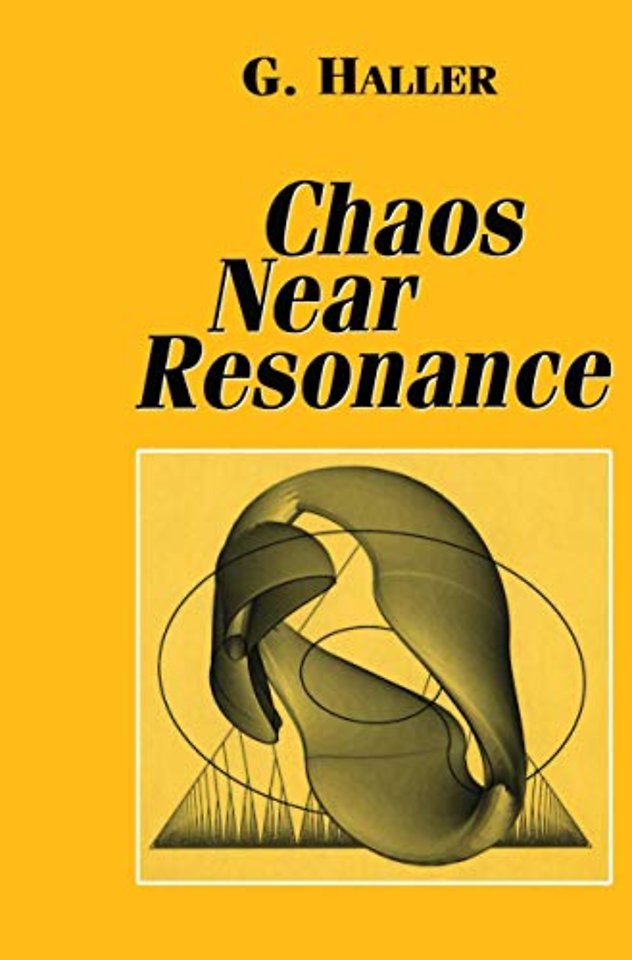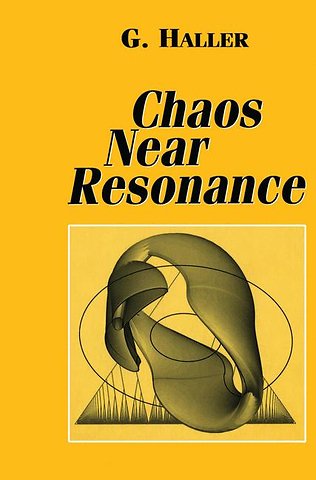Chaos Near Resonance
Gebonden Engels 1999 1999e druk 9780387986975Samenvatting
A unified treatment of resonant problems with special emphasis on the recently discovered phenomenon of homoclinic jumping. After a survey of the necessary background, the book develops a general finite dimensional theory of homoclinic jumping, illustrating it with examples. The main mechanism of chaos near resonances is discussed in both the dissipative and the Hamiltonian context, incorporating previously unpublished new results on universal homoclinic bifurcations near resonances, as well as on multi-pulse Silnikov manifolds. The results are applied to a variety of different problems, which include applications from beam oscillations, surface wave dynamics, nonlinear optics, atmospheric science and fluid mechanics.
Specificaties
Lezersrecensies
Inhoudsopgave
\in = \sqrt \mu $$.- 3.2.5 The Inclusion of the $$
\mathcal{O}\left( {{\mu ^v}} \right)$$ Time-Dependent Terms.- 3.2.6 Comparison With the Simonelli—Gollub Experiment.- 3.3 Chaotic Pitching of Nonlinear Vibration Absorbers.- 3.3.1 The Mechanical Model.- 3.3.2 A More General Class of Problems.- 3.4 Mechanical Systems With Widely Spaced Frequencies.- 3.4.1 A Two-Mode Model.- 3.4.2 The Geometry of Energy Transfer.- 3.4.3 An Example.- 3.5 Irregular Particle Motion in the Atmosphere.- 3.5.1 The Model.- 3.5.2 Phase Space Geometry and Its Physical Meaning.- 3.6 Subharmonic Generation in an Optical Cavity.- 3.6.1 A Two-Mode Model.- 3.6.2 The Ideal Cavity (? = 0).- 3.6.3 Chaotic Dynamics for ? > 0.- 3.7 Intermittent Bursting in Turbulent Boundary Layers.- 3.7.1 Modal Equations With Weak O(2) ? D4 Symmetry Breaking.- 3.7.2 The Slow Manifold.- 3.7.3 Fast Heteroclinic Cycles.- 3.8 Further Problems.- 4 Resonances in Hamiltonian Systems.- 4.1 Resonant Equilibria.- 4.1.1 Birkhoff Normal Form.- 4.1.2 A Class of 1 : 2 : k Resonances.- 4.1.3 Geometry of the Normal Form.- 4.1.4 Homoclinic Orbits in the Two-Degree-of-Freedom Subsystem.- 4.1.5 Homoclinic Jumping in the Normal Form.- 4.1.6 Homoclinic Jumping and Chaos in the Full Problem.- 4.2 The Classical Water Molecule.- 4.2.1 The Normal Form.- 4.2.2 Homoclinic Chaos and Energy Transfer.- 4.3 Dynamics Near Intersecting Resonances.- 4.3.1 Arnold Diffusion in Near-Integrable Systems.- 4.3.2 Cross-Resonance Diffusion.- 4.3.3 Normal Form for Weak—Strong Double Resonances.- 4.3.4 The Pendulum-Type Hamiltonian.- 4.3.5 Dynamics in the Full Normal Form.- 4.4 An Example From Rigid Body Dynamics.- 4.5 Resonances in A Priori Unstable Systems.- 4.5.1 A Physical Example.- 4.5.2 Whiskered Tori.- 4.5.3 Resonances on Invariant Manifolds.- 4.5.4 Cross-Resonance Diffusion, Homoclinic Bifurcations, and Horseshoes.- 5 Chaotic Jumping Near Resonances: Infinite-Dimensional Systems.- 5.1 The Main Examples.- 5.2 Assumptions and Definitions.- 5.2.1 The Phase Space and the Evolution Equation.- 5.2.2 Regularity and Geometric Assumptions.- 5.2.3 N-Chains of Homoclinic Orbits.- 5.3 Invariant Manifolds and Foliations.- 5.3.1 Partially Slow Manifold.- 5.3.2 Preliminary Normal Form.- 5.3.3 Smooth Foliations for Wlocs(M?,k) and Wlocu(M?,k).- 5.3.4 N-Pulse Homoclinic Orbits.- 5.4 Passage Lemmas.- 5.4.1 Fenichel Normal Form.- 5.4.2 Entry Conditions and Passage Time.- 5.4.3 Local Estimates.- 5.5 Tracking Lemmas.- 5.5.1 The Local Map.- 5.5.2 The Global Map.- 5.6 Energy Lemmas.- 5.6.1 Energy as a Coordinate.- 5.6.2 Energy of Entry Points.- 5.6.3 Improved Local Estimates.- 5.6.4 Energy of Projected Entry Points.- 5.7 Multipulse Homoclinic Orbits in Sobolev Spaces.- 5.7.1 Definitions and Notation.- 5.7.2 Existence Theorem.- 5.7.3 Remarks on Applications of the Main Theorem.- 5.7.4 Chain-Independent Energy Functions.- 5.7.5 Formulation With Other Invariants.- 5.8 Disintegration of Invariant Manifolds Through Jumping.- 5.9 Generalized Šilnikov Orbits.- 5.10 The Purely Hamiltonian Case.- 5.10.1 Universal Homoclinic Bifurcations.- 5.11 Homoclinic Jumping in the Perturbed NLS Equation.- 5.11.1 Homoclinic Tree in the Forced NLS Equation $$
\hat D \equiv 0$$.- 5.11.2 N -Pulse Orbits in the Damped—Forced NLS Equation.- 5.11.3 Šilnikov-Type Orbits in the Damped—Forced NLS Equation.- 5.12 Partially Slow Manifolds of Higher Codimension.- 5.12.1 Setup.- 5.12.2 Existence Theorem for Multipulse Orbits.- 5.12.3 Multipulse Šilnikov Manifolds.- 5.13 Homoclinic Jumping in the CNLS System.- 5.13.1 Homoclinic Jumping in the Forced CNLS Equations (?k = ?k = 0).- 5.13.2 N-Pulse Jumping Orbits in the Damped—Forced CNLS System ?k.- 5.13.3 N-Pulse Šilnikov Manifolds in the Full CNLS System.- 5.14 Bibliographical Notes.- A Elements of Differential Geometry.- A.1 Manifolds.- A.2 Tangent, Cotangent, and Normal Bundles.- A.3 Transversality.- A.4 Maps on Manifolds.- A.5 Regular and Critical Points.- A.6 Lie Derivative.- A.7 Lie Algebras, Lie Groups, and Their Actions.- A.8 Orbit Spaces.- A.9 Infinite-Dimensional Manifolds.- A.10 Differential Forms.- A.11 Maps and Differential Forms.- A.12 Exterior Derivative.- A.13 Closed and Exact Forms.- A.14 Lie Derivative of Forms.- A.15 Volume Forms and Orientation.- A.16 Symplectic Forms.- A.17 Poisson Brackets.- A.18 Integration on Manifolds and Stokes’s Theorem.- B Some Facts From Analysis.- B.1 Fourier Series.- B.2 Gronwall Inequality.- B.3 Banach and Hilbert Spaces.- B.4 Differentiation and the Mean Value Theorem.- B.5 Distributions and Generalized Derivatives.- B.6 Sobolev Spaces.- B.8 Factorization of Functions With a Zero.- References.- Symbol Index.
Rubrieken
- advisering
- algemeen management
- coaching en trainen
- communicatie en media
- economie
- financieel management
- inkoop en logistiek
- internet en social media
- it-management / ict
- juridisch
- leiderschap
- marketing
- mens en maatschappij
- non-profit
- ondernemen
- organisatiekunde
- personal finance
- personeelsmanagement
- persoonlijke effectiviteit
- projectmanagement
- psychologie
- reclame en verkoop
- strategisch management
- verandermanagement
- werk en loopbaan

